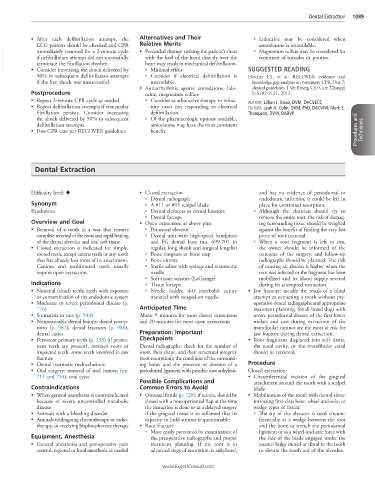Page 2183 - Cote clinical veterinary advisor dogs and cats 4th
P. 2183
Dental Extraction 1089
• After each defibrillation attempt, the Alternatives and Their ○ Lidocaine may be considered when
amiodarone is unavailable.
ECG pattern should be checked and CPR Relative Merits ○ Magnesium sulfate may be considered for
immediately resumed for a 2-minute cycle
• Precordial thump: striking the patient’s chest
VetBooks.ir if defibrillation attempt did not successfully with the heel of the hand directly over the treatment of torsades de pointes.
terminate the fibrillation rhythm.
heart may result in mechanical defibrillation.
• Consider increasing the shock delivered by
50% in subsequent defibrillation attempts ○ Minimal effect SUGGESTED READING
○ Consider if electrical defibrillation is
Fletcher DJ, et al: RECOVER evidence and
if the first shock was unsuccessful. unavailable. knowledge gap analysis on veterinary CPR. Part 7:
• Antiarrhythmic agents: amiodarone, lido- clinical guidelines. J Vet Emerg Crit Care 22(suppl
Postprocedure caine, magnesium sulfate 1):S102-S131, 2012.
• Repeat 2-minute CPR cycle as needed. ○ Consider as adjunctive therapy in refrac- AUTHOR: Lillian I. Good, DVM, DACVECC
• Repeat defibrillation attempts if ventricular tory cases not responding to electrical EDITORS: Leah A. Cohn, DVM, PhD, DACVIM; Mark S.
fibrillation persists. Consider increasing defibrillation. Thompson, DVM, DABVP
the shock delivered by 50% in subsequent ○ Of the pharmacologic options available,
defibrillation attempts. amiodarone may have the most consistent
• Post-CPR care per RECOVER guidelines benefit. Procedures and Techniques
Dental Extraction
Difficulty level: ♦ • Closed extraction and has no evidence of periodontal or
○ Dental radiograph endodontic infection, it could be left in
Synonym ○ A #11 or #15 scalpel blade place for continued resorption.
Exodontics ○ Dental elevators or dental luxators ○ Although the clinician should try to
○ Dental forceps remove the entire root, the risk of damag-
Overview and Goal • Open extraction: as above plus ing surrounding tissue should be weighed
• Removal of a tooth in a way that ensures ○ Periosteal elevator against the benefit of finding the very last
complete removal of the roots and rapid healing ○ Dental unit with high-speed handpiece piece of root material.
of the dental alveolus and oral soft tissue and FG dental burs (no. 699-701 in ○ When a root fragment is left in situ,
• Closed extraction is indicated for simple, regular, long shank and surgical lengths) the owner should be informed of the
rooted teeth, except canine teeth or any tooth ○ Bone rongeurs or bone rasp outcome of the surgery, and follow-up
that has already lost most of its attachment. ○ Bone curette radiographs should be planned. The risk
Canines and multirooted teeth usually ○ Sterile saline with syringe and atraumatic of causing an abscess is higher when the
require open extraction. needle root was infected or the fragment has been
○ Soft-tissue scissors (LaGrange) mobilized and its blood supply severed
Indications ○ Tissue forceps during its attempted extraction.
• Nonvital (dead) teeth; teeth with exposure ○ Needle holder, 4-0 resorbable suture • Jaw fracture: usually the result of a blind
or contamination of the endodontic system material with swaged-on needle attempt at extracting a tooth without pre-
• Moderate to severe periodontal disease (p. operative dental radiographs and appropriate
776) Anticipated Time treatment planning. Small-breed dogs with
• Stomatitis in cats (p. 943) About 5 minutes for most closed extractions severe periodontal disease of the first lower
• Nonrestorable dental lesions: dental resorp- and 20 minutes for most open extractions molars and cats during extraction of the
tions (p. 982), dental fractures (p. 980), mandibular canines are the most at risk for
dental caries Preparation: Important jaw fracture during dental extraction.
• Persistent primary teeth (p. 238) (if perma- Checkpoints • Root fragments displaced into soft tissue,
nent teeth are present), retained roots or Dental radiographs: check for the number of the nasal cavity, or the mandibular canal
impacted teeth, some teeth involved in jaw roots, their shape, and their structural integrity should be retrieved.
fracture (root resorption); the condition of the surround-
• Dental traumatic malocclusions ing bone; and the presence or absence of a Procedure
• Oral surgery: removal of oral tumors (pp. periodontal ligament with possible root ankylosis. Closed extraction:
711 and 714), oral cysts • Circumferential incision of the gingival
Possible Complications and attachment around the tooth with a scalpel
Contraindications Common Errors to Avoid blade
• When general anesthesia is contraindicated • Oronasal fistula (p. 720): if occurs, should be • Mobilization of the tooth with dental eleva-
because of severe uncontrolled metabolic closed with a mucoperiosteal flap at the time tors using first-class lever, wheel-and-axle, or
disease the extraction is done or as a delayed surgery wedge types of forces:
• Animals with a bleeding disorder if the gingival tissue is so inflamed that its ○ The tip of the elevator is used circum-
• Animals undergoing chemotherapy or radio- capacity to hold sutures is questionable. ferentially as a wedge between the root
therapy, or receiving bisphosphonate therapy • Root fracture and the bone to stretch the periodontal
○ Most easily prevented by examination of ligament or as a wheel-and-axle force with
Equipment, Anesthesia the preoperative radiographs and proper the side of the blade engaged under the
• General anesthesia and perioperative pain treatment planning. If the root is in enamel bulge mesial or distal to the tooth
control; regional or local anesthesia as needed advanced stage of resorption, is ankylosed, to elevate the tooth out of the alveolus.
www.ExpertConsult.com

